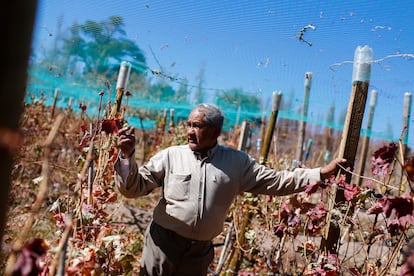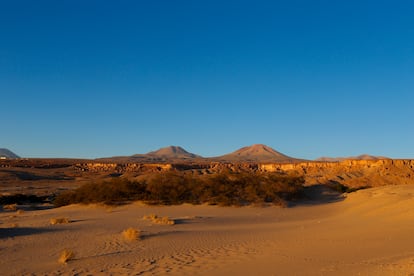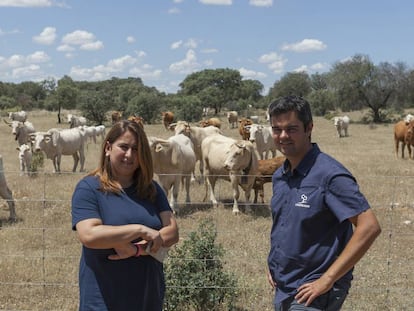How wine is produced at 12,000 feet in the driest place in the world
A cooperative of producers in Atacama, Chile is revolutionizing the sector: two of its labels have received gold medals at an international extreme wine competition


In the driest place in the world, at 3,600 meters (almost 12,000 feet) above sea level, a vineyard breaks through the desert landscape of Atacama. The half hectare (about 50 acres) of vines sprouts in the remote village of Socaire, nestled between ravines with views of the salt flat. Farmer Cecilia Cruz, 67, a native of the area, walks through the volcanic sand floor covered with dry leaves. With her hands, molded by working the land, she picks one of the few grapes that are on the vine after the harvest season: “Never in my life had I seen a grape being produced here in the highlands,” says the owner of Caracoles vineyard, the highest in Chile. “My neighbors didn’t think I could harvest the grapes. Now they ask me to come see the bunches, to taste the grapes, they can’t believe it,” she adds, proud of her viticultural feat. As she speaks, a fox prowls around the vineyard. “When the fox eats the grape, it’s good,” says a local resident.

Like most of her neighbors, Cecilia was dedicated to harvesting and selling corn, broad beans and alfalfa. In 2010, a man invited her to occupy land in the highlands to grow vines. After discussing it with her three children, she agreed to be part of the Atacama Fertile Land program of SQM (Chilean Chemical and Mining Society). She was given plants and sticks and was advised by engineers and winemakers. Irrigation? The village is supplied by the melted snow in the Andes Mountains that flows down a natural channel. In the neighboring towns, the water that arrives has such a quantity of minerals and salts that it is not suitable for growing grapes. But in Los Caracoles vineyard, after four years of failed attempts, and applying the irrigation system once a week, the clusters yielded fruit.
In 2017, Cecilia joined the High-Altitude Vintners Cooperative Lickanantay, made up only of producers descending from the native Atacama residents of Socaire, Toconao, Celeste and San Pedro de Atacama. Of the fifty producers who started, 18 continue. The rest left because they were unable to harvest the grapes due to the extreme weather conditions or they did not dedicate the necessary time and care to it, says Fabián Muñoz, winemaker at the Ayllú vineyard, which brings together all the cooperative members.
“In the central valley, the vine is in its optimal growth conditions. Here it is the opposite, the plant is naturally stressed. The fact that the vines grow in rocky soils, at high elevation, with less oxygen, subjected to sudden changes in temperature and high solar irradiation, means that this stress generates quality control by itself, the skin of the grape is thicker, and its flavor is more intense. But we must be much more aware of generating the necessary conditions so that it does not die on us,” explains Muñoz.

In each bottle of the seven Ayllú lines, an assembly of the product of the 18 cooperative members is carried out. Two of its wines (Ayllu Sweet Muscatel 2020 and Ayllu Orange 2020) received gold medals at last year’s international extreme wine competition Mondial des Vins Extrêmes held in Italy. This year their goal was to harvest 18,000 kilos (about 39,680 pounds) of grapes, and they reached 22,000 kilos (48,500 pounds). The goal is to increase another 2,000 kilos (4,410 pounds) at the next harvest. “When the cooperative began, we dedicated ourselves to agronomic work, then to winemaking. In 2020 we changed our image to focus on marketing. We have won medals, and now we are expanding nationally and internationally,” says the winemaker. Chile is the fourth leading world exporter of wine.
Between pucarás (indigenous fortresses) and cemeteries of the ancient Atacameño people, chemical engineer Samuel Varas, 43, set up the Chajnantor vineyard in Zapar. It is one of the cooperative’s most innovative vineyards. “Through trial and error, we managed to achieve grape production with more technology,” he explains. “Due to an ecological issue, we did not want to accumulate water-cell batteries, so we work with solar panels. These capture sunlight and transform it into alternating current. That current works like traditional batteries,” he says amid his 2,000 vines fed by an automated irrigation system. Part of the financing was obtained from a government program that subsidizes indigenous agricultural projects. The first year of production yielded 150 kilos (330 pounds), the third 500 (1,100 pounds) and for the next, he aspires to a ton.
In some areas of the desert there are records of vine plantations since colonial times. Cooperative members explain that they have always worked with ordinary black grapes. The innovation consists of planting premium varieties such as Syrah, Cabernet, Petit Verdot, among others. Héctor Espinola, 71, has been in winemaking for almost half a century. He used to sell wine of Criollo grape varieties. He also cultivated pears and quinces, but in recent years the competition from other areas lowered prices and he no longer broke even. For this reason, when he was invited to join the cooperative, he uprooted all his fruit orchards and harvested a hectare (about 100 acres) of Malbec grapes. Today he owns the San Juan vineyard in Bosque Viejo, 2,500 meters above sea level. “We deliver the grapes, and the winemakers turn it into wine. Each bottle is sold for $12, and they give me 60% of the earnings. This year I put out 500 bottles,” he says. “I am doing much better than when I was selling pears and quinces.”

Tu suscripción se está usando en otro dispositivo
¿Quieres añadir otro usuario a tu suscripción?
Si continúas leyendo en este dispositivo, no se podrá leer en el otro.
FlechaTu suscripción se está usando en otro dispositivo y solo puedes acceder a EL PAÍS desde un dispositivo a la vez.
Si quieres compartir tu cuenta, cambia tu suscripción a la modalidad Premium, así podrás añadir otro usuario. Cada uno accederá con su propia cuenta de email, lo que os permitirá personalizar vuestra experiencia en EL PAÍS.
¿Tienes una suscripción de empresa? Accede aquí para contratar más cuentas.
En el caso de no saber quién está usando tu cuenta, te recomendamos cambiar tu contraseña aquí.
Si decides continuar compartiendo tu cuenta, este mensaje se mostrará en tu dispositivo y en el de la otra persona que está usando tu cuenta de forma indefinida, afectando a tu experiencia de lectura. Puedes consultar aquí los términos y condiciones de la suscripción digital.
More information

Meet Spain’s unlikely 21st-century shepherds
Últimas noticias
Chris Martin, Taylor Swift, Elijah Wood and other famous wedding ‘crashers’
‘How does it feel to be a failure?’: Elizabeth Berkley’s journey from ‘Showgirls’ ridicule to vindication
The story of the Málaga virus: The code that haunted Google’s cybersecurity center director for 30 years
The impact of Ecuador’s mega-prison: A polluted river, cleared forests and military checkpoints
Most viewed
- Christian Louboutin: ‘Young people don’t want to be like their parents. And if their parents wear sneakers, they’re going to look for something else’
- The low-cost creative revolution: How technology is making art accessible to everyone
- Liset Menéndez de la Prida, neuroscientist: ‘It’s not normal to constantly seek pleasure; it’s important to be bored, to be calm’
- All the effects of gentrification in one corner of Mexico’s Colonia Roma
- December Social Security and SSI payments: Dates, double checks and the 2026 COLA increase








































